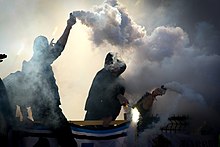狂热球迷
狂热球迷(Ultras)是以疯狂支持足球而闻名的足球迷文化。这个术语起源于意大利,但广泛使用在世界各地,用于描述有集体组织的足球俱乐部球迷。狂热球迷团体的行为倾向包括高唱应援歌、演奏鼓等乐器、使用发焰筒和发烟筒、在足球场上展示旗帜和横幅等,所有这些行为的目的是营造士气鼓励自己支持球队,并营造威吓对方球员及其支持者的氛围。


尽管与足球流氓集团不同,狂热球迷并没有与敌方球迷打斗的明确目标,但狂热球迷对许多足球流氓行为及暴力案件负有责任。[1][2] 某些情况下,狂热球迷还与新纳粹主义、其他形式的极右翼[3][4][5] 或极左翼[6][7] 政治意识形态直接相关。这些流氓和政治化行为的现象,甚至更胜于表现对球队的支持,成为狂热支持者的次要特征。[8]
2000年代后期开始,狂热球迷文化成为反对体育和足球商业化的焦点。[9] 狂热球迷在其他区域也有变体术语,例如:西班牙语美洲的拉丁美洲狂热球迷(barra bravas)[10]和巴西的巴西狂热球迷(Torcidas Organizadas)[11]。
另见
编辑参考资料
编辑- ^ Ultra vires. Spiked. 9 February 2007 [18 January 2011]. (原始内容存档于24 February 2011).
- ^ What is a football ultra? Serie A hardcore fan culture explained.
- ^ Pantelick, Nicolas. Fanaticism and the "Ultras" Movement: How Far Will You Go to Support Your Team?. Harvard International Review. 2 February 2022 [2023-09-25]. (原始内容存档于2024-01-09).
- ^ Parkin, Simon. The rise of Russia’s neo-Nazi football hooligans. The Guardian. 24 April 2018 [2023-09-25]. (原始内容存档于2024-02-01).
- ^ The dark heart of Italian soccer. CBC Sports. 15 April 2005 [18 January 2011]. (原始内容存档于24 February 2011).
- ^ Learning from adjacent fields: the relation between extremism and hooliganism (PDF). home-affairs.ec.europa.eu. 25–26 Oct 2018 [4 August 2023]. (原始内容存档 (PDF)于Jul 17, 2023) (英语).
- ^ Jones, Tobias. 1312 by James Montague review – inside the world of football's ultras. The Guardian. 2020-03-26 [2023-07-04]. ISSN 0261-3077. (原始内容存档于2023-12-22) (英国英语).
- ^ Fan tragedy sends the fight against Ultras back to square one. The Guardian. 12 November 2007 [18 January 2011]. (原始内容存档于4 December 2013).
- ^ Are German fans really turning against the beautiful game?. The Guardian. 7 April 2008 [18 January 2011]. (原始内容存档于4 December 2013).
- ^ World Cup 2022: Argentina's 'barras bravas' bring the noise – DW – 12/11/2022. dw.com. [2023-03-08]. (原始内容存档于2024-02-19) (英语).
- ^ Torcidas Organizadas: Torcidas Organizadas no Brasil e no Mundo. Brasil Escola. [2023-03-08]. (原始内容存档于2023-03-08) (巴西葡萄牙语).
外部链接
编辑| 这是一篇与体育运动相关的小作品。您可以通过编辑或修订扩充其内容。 |